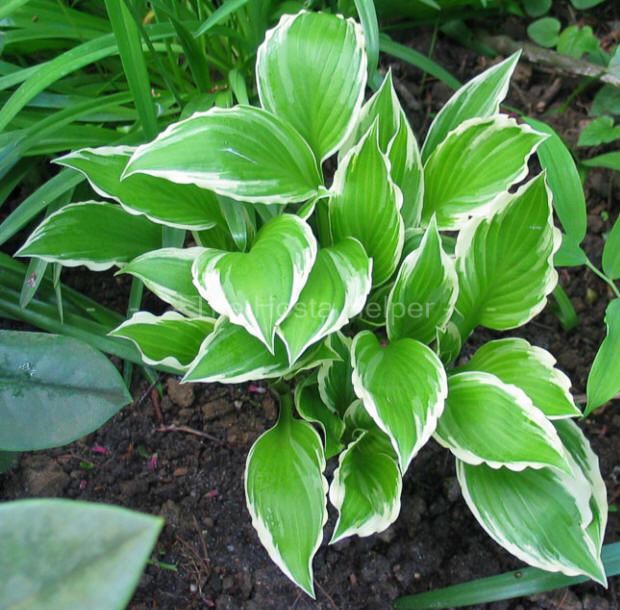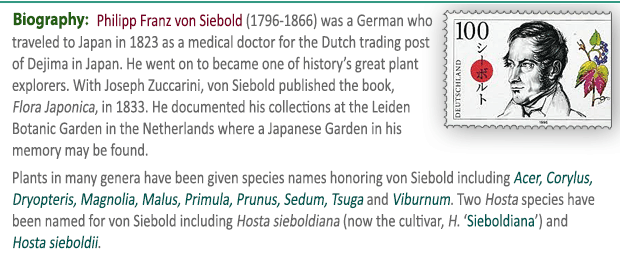|
 According to
The Hostapedia by Mark Zilis (2009), "...most commonly planted white-margined hosta
in the last 100 years." According to
The Hostapedia by Mark Zilis (2009), "...most commonly planted white-margined hosta
in the last 100 years."
This medium size (18 inches high by 36 inches
wide) plant has pale
lavender flowers with a mid-petal stripe in July. The flowers are
sterile so they do not develop seeds.
 Schmid (1991) changed the naming of this plant. Previously, it was
known as a species by the name of Hosta undulata
albo-marginata. As the current name implies, it has now been
switched to cultivar status rather than a species. The most
common reason for this switch is that there is no evidence that
this plant exists now or has ever existed as a plant in the
wild. In other words, it is a cultivated plant. Schmid (1991) changed the naming of this plant. Previously, it was
known as a species by the name of Hosta undulata
albo-marginata. As the current name implies, it has now been
switched to cultivar status rather than a species. The most
common reason for this switch is that there is no evidence that
this plant exists now or has ever existed as a plant in the
wild. In other words, it is a cultivated plant.
Zilis also points out the this
plant was originally registered by
The American Hosta Society as
H. undulata 'Albo-marginata' in 1987. Other names that
have been used for this plant in the past include 'Frank Sedgewick', 'Mackwoods No. 5', and Hosta japonica undulata
aureo-marginata.
From the
Field Guide to Hostas by Mark Zilis (2014), "...stands as the most widely used white-margined hosta in American landscapes
in the twentieth century...looks great during April, May and June...deteriorates
in July..."
The New Encyclopedia of Hostas by
Diana
Grenfell (2009) states: "Adaptable to many situations. Especially useful
for covering large areas...Leaves less twisted and less undulate that those of
H. 'Crispula', with which it is often confused."
It may have been sold at one time as Mackwoods
No. 5.

 An article about H. 'Undulata' and its origins by
Bob Solberg in
The
Hosta Journal (1996 Vol. 27 No. 1) states that, "H. 'Undulata
Albomarginata' is an interspecific hybrid of
H. sieboldii x
H. montana but of
different individual parentage than H. 'Undulata'. It was probably sold to
Thomas Hogg in 1875 in Yokohama, Japan. It is not a sport of H. 'Undulata' or H.
'Undulata
Erromena', the white-edged sport of the latter being H. 'See
Saw'...While the data presented here strongly support these conclusions, they do
not provide absolute proof. DNA testing of these cultivars would prove very
interesting." An article about H. 'Undulata' and its origins by
Bob Solberg in
The
Hosta Journal (1996 Vol. 27 No. 1) states that, "H. 'Undulata
Albomarginata' is an interspecific hybrid of
H. sieboldii x
H. montana but of
different individual parentage than H. 'Undulata'. It was probably sold to
Thomas Hogg in 1875 in Yokohama, Japan. It is not a sport of H. 'Undulata' or H.
'Undulata
Erromena', the white-edged sport of the latter being H. 'See
Saw'...While the data presented here strongly support these conclusions, they do
not provide absolute proof. DNA testing of these cultivars would prove very
interesting."
|
 |
 |
|
|
"I am
willing to bet just about every garden
has this one. It may not be as showy as
the others, but it is a landscaping
workhorse. Extremely inexpensive and
available everywhere for around $3.00,
it can be bought in quantity and so can
make an immediate statement in the
garden. Wonderful for edging large lawns
or walks through the woodland garden. At
dusk its glowing white margins guide one
around the place. This hybridogeneous
speciod multiplies like wild fire." |
|








 |



